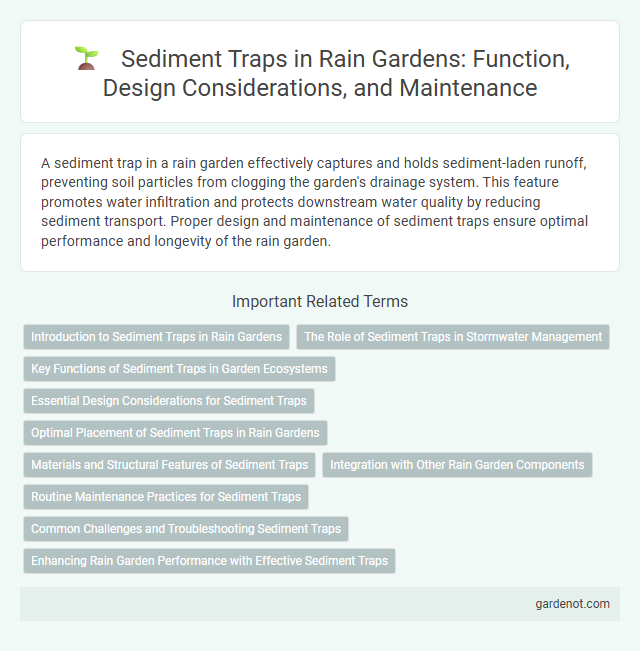A sediment trap in a rain garden effectively captures and holds sediment-laden runoff, preventing soil particles from clogging the garden's drainage system. This feature promotes water infiltration and protects downstream water quality by reducing sediment transport. Proper design and maintenance of sediment traps ensure optimal performance and longevity of the rain garden.
Introduction to Sediment Traps in Rain Gardens
Sediment traps in rain gardens act as critical features designed to capture and retain soil particles and pollutants carried by stormwater runoff. These traps prevent sediment from clogging the rain garden's soil media, thus maintaining the garden's filtration efficiency and overall health. Positioned strategically at the inlet or along flow paths, sediment traps extend the lifespan of rain gardens while enhancing water quality management.
The Role of Sediment Traps in Stormwater Management
Sediment traps play a critical role in stormwater management by capturing and temporarily storing sediment-laden runoff before it enters a rain garden. These structures reduce sediment accumulation within the rain garden, preserving soil permeability and promoting the infiltration of clean water. Effective sediment trapping minimizes pollutant load, protects aquatic ecosystems, and enhances the overall performance of stormwater treatment systems.
Key Functions of Sediment Traps in Garden Ecosystems
Sediment traps in rain gardens play a vital role in capturing and retaining soil particles and debris before they enter water bodies, thereby reducing sediment pollution and protecting aquatic habitats. They enhance water quality by filtering out contaminants and promoting infiltration, which supports healthier plant growth and stabilizes soil structure. Effective sediment traps prevent clogging of drainage systems and minimize erosion, ensuring the long-term sustainability of garden ecosystems.
Essential Design Considerations for Sediment Traps
Sediment traps in rain gardens must be strategically sized to capture sediment effectively without impeding water flow, prioritizing a depth of at least 12 inches to allow sufficient settling time. Placement near the inflow area enhances sediment capture before water disperses, while incorporating an easy-access cleanout mechanism ensures regular maintenance and prevents clogging. Using durable, non-erodible materials for the trap's structure increases longevity and supports consistent filtration performance.
Optimal Placement of Sediment Traps in Rain Gardens
Sediment traps in rain gardens should be strategically placed at inflow points where runoff first enters the garden to maximize sediment capture and prevent clogging. Positioning traps near the garden's perimeter allows for efficient sediment removal before water disperses, enhancing overall filtration performance. Proper elevation and sizing of sediment traps ensure they effectively slow water flow and allow heavier particles to settle, maintaining the garden's long-term function.
Materials and Structural Features of Sediment Traps
Sediment traps in rain gardens commonly use materials such as gravel, sand, and geotextiles to capture and filter suspended solids effectively. Structural features typically include basins or forebays designed to slow water flow, allowing sediment to settle before water enters the main infiltration area. These traps often incorporate removable sediment storage compartments to facilitate maintenance and prevent clogging, enhancing the overall longevity and efficiency of the rain garden system.
Integration with Other Rain Garden Components
Sediment traps enhance rain garden performance by capturing and containing soil particles before they enter the main planting area, preventing clogging and promoting water infiltration. Strategically positioned at the rain garden's inflow points, sediment traps work in tandem with berms and underdrains to manage runoff effectively. Integrating sediment traps with native vegetation and mulch layers further stabilizes soil and supports pollutant removal processes within the rain garden system.
Routine Maintenance Practices for Sediment Traps
Sediment traps in rain gardens require routine maintenance to ensure optimal water infiltration and prevent clogging. Regular removal of accumulated sediments, typically every 6 to 12 months depending on local sediment load, maintains trap functionality and prolongs the life of the rain garden. Inspection after major storms is crucial to identify excessive sediment build-up and address erosion issues promptly.
Common Challenges and Troubleshooting Sediment Traps
Sediment traps in rain gardens often face clogging due to excessive sediment accumulation, reducing water infiltration and causing overflow issues. Common challenges include inadequate sizing, improper maintenance, and sediment buildup from upstream erosion or runoff. Regular inspection and timely removal of trapped sediment are essential to maintain optimal functionality and prevent system failure.
Enhancing Rain Garden Performance with Effective Sediment Traps
Sediment traps in rain gardens play a crucial role in capturing and retaining soil particles, preventing sediment buildup that can clog drainage systems and reduce infiltration rates. Properly designed sediment traps enhance the longevity and efficiency of rain gardens by maintaining clean water flow and promoting healthier plant growth. Incorporating features like gravel or mulch layers in these traps improves sediment filtration while facilitating groundwater recharge and reducing runoff pollution.
Sediment trap Infographic

 gardenot.com
gardenot.com